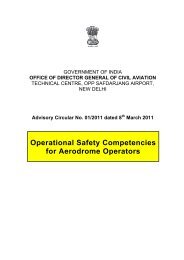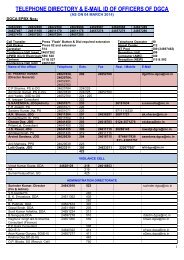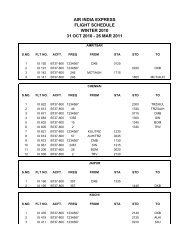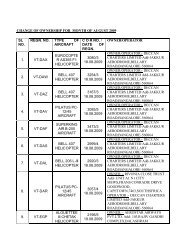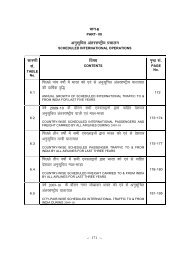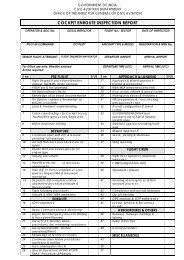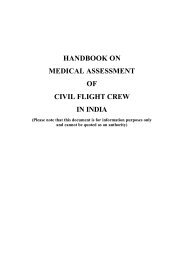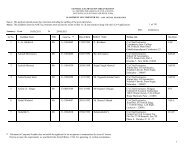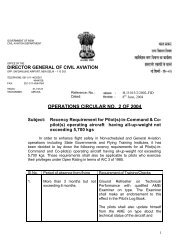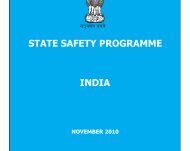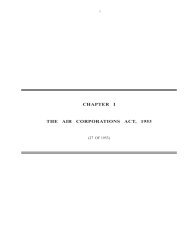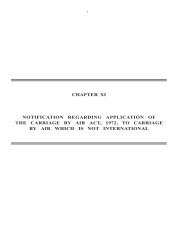aerodrome advisory circular - Directorate General of Civil Aviation
aerodrome advisory circular - Directorate General of Civil Aviation
aerodrome advisory circular - Directorate General of Civil Aviation
Create successful ePaper yourself
Turn your PDF publications into a flip-book with our unique Google optimized e-Paper software.
ΕισαγωγήΗ Υπηρεσία Πληροφορικών Συστημάτων παρέχει στην ΠανεπιστημιακήΚοινότητα γενικής χρήσης και πρόσβασης εργαστήρια ηλεκτρονικώνυπολογιστών για τη υποστήριξη του έργου της. Την περίοδο αυτήλειτουργούν συνολικά έξι (6) εργαστήρια ως πιο κάτω:• Κεντρικό Κτίριο – Στον πρώτο όροφο του κτιρίου της ΥπηρεσίαςΠληροφορικών Συστημάτων λειτουργούν 3 εργαστήρια - 1Οπτικοακουστικών• Λατσιά – 1 εργαστήριο• Πανεπιστημιούπολη – 1 εργαστήριοΛεπτομέρειες για το κάθε εργαστήριοΤρία από τα εργαστήρια λειτουργούν στο κεντρικό κτίριο του Πανεπιστήμιουστο πρώτο όροφο της Υπηρεσίας Πληροφορικών Συστημάτων• Εργαστήριο 30 μικροϋπολογιστών – Αίθουσα Π103.Τα συστήματα τρέχουν σε περιβάλλον Windows2000. Στουςυπολογιστές είναι εγκατεστημένα τα λογισμικά γενικής χρήσεως: MSOFFICE, Iexpoler, Minitab, SPSS, SAS.• Εργαστήριο 30 μικροϋπολογιστών – Αίθουσα Π102. Τα συστήματατρέχουν σε περιβάλλον Windows2000. Στους υπολογιστές είναιεγκατεστημένα τα λογισμικά γενικής χρήσεως.• Εργαστήριο 30 σταθμών εργασίας AIX – Αίθουσα Π101. Τασυστήματα λειτουργούν σε περιβάλλον UNIX. Σε αυτό το εργαστήριοείναι εγκατεστημένα λογισμικά γενικής χρήσεως καθώς και γλώσσεςπρογραμματισμού, όπως η C, C++, Fortran, Pascal, Modula 2, Prolog,Assembler, Oracle και Access.• Εργαστήριο Οπτικοακουστικών Μέσων– ΑίθουσαA016 Αποτελείται από 25 οθόνες, 25 βίντεο, ακουστικό σύστημακαι κεντρική κονσόλα με δύο τηλεοράσεις 27”.• Εργαστήριο 30 μικροϋπολογιστών στο παράρτημα Λατσιών. Τασυστήματα αυτά επίσης τρέχουν σε περιβάλλον Windows2000. Στοεργαστήριο αυτό είναι εγκατεστημένα τα λογισμικά γενικής χρήσηςκαθώς και κάποια εξειδικευμένα προγράμματα που χρησιμοποιούνταικυρίως για μαθήματα του τμήματος Επιστημών της Αγωγής.2
GUIDELINES FOR PREPARATION & AD AC 1/2006MAINTANANCE OF AERODROME MANUALa) the role <strong>of</strong> <strong>aerodrome</strong> operator, aircraft operator, <strong>aerodrome</strong> fixed-baseoperators, BCAS/<strong>aerodrome</strong> security entity, the DGCA and other governmentdepartments, as applicable; andb) the names and role <strong>of</strong> the personnel responsible for controlling access to the<strong>aerodrome</strong> and the telephone number for contacting those personnel duringand after working hours.AERODROME EMERGENCY PLANParticulars: <strong>of</strong> the <strong>aerodrome</strong> emergency plan, including the following:a) plans for dealing with emergencies occurring at the <strong>aerodrome</strong> or in itsvicinity, including malfunction <strong>of</strong> aircraft in flight, structural fires, sabotageincluding bomb threat (aircraft or structure), unlawful seizure <strong>of</strong> aircraft andincidents on the airport covering "during the emergency" and "after theemergency" considerations;b) details <strong>of</strong> tests for <strong>aerodrome</strong> facilities and equipment to be used inemergencies, including the frequency <strong>of</strong> these tests;c) details <strong>of</strong> exercises to test emergency plans, including the frequency <strong>of</strong> thoseexercises;d) arrangements for reviewing the frequency <strong>of</strong> those exercises;e) list <strong>of</strong> organizations, agencies and persons <strong>of</strong> authority both on- and <strong>of</strong>fairportfor site roles; their telephone numbers, fax and e-mail addressdirectory, SITA code directory and radio frequencies <strong>of</strong> <strong>of</strong>fices;f) establishment <strong>of</strong> an <strong>aerodrome</strong> emergency committee preparations fordealing with emergencies; andg) appointment <strong>of</strong> an on-scene commander <strong>of</strong> an overall emergency operation.RESCUE AND FIRE FIGHTINGParticulars <strong>of</strong> the facilities, equipment, personnel and procedures for meeting therescue and fire fighting requirements, including the names and roles <strong>of</strong> the personsresponsible for dealing with the rescue and fire fighting services at the <strong>aerodrome</strong>.Note. - This subject should also be covered in appropriate detail in the AerodromeEmergency Plan.AERODROME MOVEMENT AREA AND OBSTACLE LIMITATION SURFACEINSPECTION BY THE AERODROME OPERATORParticulars <strong>of</strong> the procedures for the inspection <strong>of</strong> the <strong>aerodrome</strong> movement area andobstacle limitation surfaces, including the following:a) arrangement for carrying out inspections, including runway friction and waterdepth measurement on runways and taxiways, during and outside the normalhours <strong>of</strong> <strong>aerodrome</strong> operations,b) arrangement and means <strong>of</strong> communicating with the Air Traffic Control duringan inspection;c) arrangement for keeping an inspection logbook and the location <strong>of</strong> thelogbook;d) details <strong>of</strong> inspection intervals and times;e) inspection checklist;f) arrangement for reporting the results <strong>of</strong> the inspection and for taking promptfollow-up actions to ensure correction <strong>of</strong> unsafe conditions; andIssue I/ Rev 0Sept. 20065
GUIDELINES FOR PREPARATION & AD AC 1/2006MAINTANANCE OF AERODROME MANUALAPRON MANAGEMENTParticulars <strong>of</strong> the apron management procedures,a) Arrangement between air traffic control and the apron management unit;b) Arrangement for allocating aircraft parking positions;c) Arrangement for initiating engine start and ensuring clearance <strong>of</strong> aircraftpush-back;d) Marshalling service; ande) Follow-Me service.APRON SAFETY MANAGEMENTProcedures to ensure apron safety, including:a) protection from jet blasts;b) enforcement <strong>of</strong> safety precautions during aircraft refueling operations;c) apron sweeping;d) apron cleaning;e) arrangements for reporting incidents/accidents on an apron; andf) arrangements for auditing the safety compliance by all personnel working onthe apron.AIRSIDE VEHICLE CONTROLParticulars <strong>of</strong> the procedure for the control <strong>of</strong> surface vehicles operating on, or in thevicinity <strong>of</strong>, the movement area, including the following:a) details <strong>of</strong> the applicable traffic rules (including speed limits and the means <strong>of</strong>enforcement <strong>of</strong> the rules); andb) the method <strong>of</strong> issuing driving permits for operating vehicles in the movementarea.WILDLIFE HAZARD MANAGEMENTParticulars <strong>of</strong> the procedure to deal with danger to aircraft operations caused by thepresence <strong>of</strong> birds or mammals in the <strong>aerodrome</strong> flight pattern or movement area,including the following;a) arrangement for assessing any wildlife hazard;b) arrangement for implementing wildlife control programmes; andc) names and roles <strong>of</strong> the persons responsible:f6r dealing with wildlife hazards,and their telephone numbers during and after working hour.OBSTACLE CONTROLParticulars setting out the procedures for:a) monitoring the obstacle limitation surface and Type A Chart take-<strong>of</strong>f surfacefor obstacles:b) controlling obstacles within the authority <strong>of</strong> the operator;c) monitoring buildings or structure development in relation to their height withinthe boundaries <strong>of</strong> the obstacle limitation surface;Issue I/ Rev 0Sept. 20067
GUIDELINES FOR PREPARATION & AD AC 1/2006MAINTANANCE OF AERODROME MANUALd) the control <strong>of</strong> new developments in the vicinity <strong>of</strong> <strong>aerodrome</strong>s; ande) notifying the DGCA <strong>of</strong> the nature and location <strong>of</strong> obstacles and anysubsequent addition or removal <strong>of</strong> obstacle for necessary includingamendment <strong>of</strong> the AIS publications.DISABLED AIRCRAFT REMOVAL PLAN AND PROCEDUREParticulars <strong>of</strong> procedure for removing an aircraft which disabled on or adjacent to themovement area including the following:a) roles <strong>of</strong> the <strong>aerodrome</strong> operator and the holder <strong>of</strong> the aircraft <strong>of</strong> registration;b) arrangement for notifying the holder <strong>of</strong> the certificate <strong>of</strong> registration;c) arrangement for liaising with the air traffic control;d) arrangement for obtaining equipment and persons to remove the disabledaircraft; ande) names and roles <strong>of</strong> persons responsible for arrangement <strong>of</strong> the removal <strong>of</strong>disabled aircraft and their telephone numbers.HANDLING OF HAZARDOUS MATERIALParticulars <strong>of</strong> the procedures for die safe handling and storage <strong>of</strong> hazardous materialon the <strong>aerodrome</strong>, including the following:a) the arrangement for special areas on the <strong>aerodrome</strong> to be set-up for thestorage <strong>of</strong> inflammable liquids (including aviation fuels) and any otherhazardous materials andb) the method to be followed for the delivery, storage, dispensing and handling<strong>of</strong> hazardous materials.Note.- Hazardous materials include inflammable liquids and solid, corrosive liquids,compressed gases and magnetized or radioactive materials. The arrangement todeal with an accidental spillage <strong>of</strong> hazardous material should be included in the<strong>aerodrome</strong> emergency plan.LOW VISIBILITY OPERATIONSParticulars <strong>of</strong> procedures to be introduced for low visibility operations, including themeasurement and reporting <strong>of</strong> runway visual range, as and when required and nameand telephone numbers during and after working hours <strong>of</strong> the persons responsible formeasuring the runway visual range.PROTECTION OF SITES FOR RADAR AND NAVIGATIONAL AIDS:Particulars <strong>of</strong> the procedure for the protection <strong>of</strong> radar and radio navigational aidslocated on the <strong>aerodrome</strong> to ensure that their performance will not be degraded,including the following:a) the arrangement for the control <strong>of</strong> activities in the vicinity <strong>of</strong> radar and NavAids installations;b) the arrangement for ground maintenance in the vicinity <strong>of</strong> these installations;andIssue I/ Rev 0Sept. 20068
GUIDELINES FOR PREPARATION & AD AC 1/2006MAINTANANCE OF AERODROME MANUALc) its the supply and installations <strong>of</strong> signs warning <strong>of</strong> hazardous microwaveradiation.Note I. - In writing the procedure on each category clear and precise informationshould be include on:- when, or in what circumstances, is an operating procedure to be activated;- how is an operating procedure activated;- actions to be taken;- the person(s) to carry out the actions; and- equipment, and access to such equipment, necessary for carrying out theactions.Note 2. - If any <strong>of</strong> the procedures specific above is not relevant or applicable, thereason should be given.PART 5 -AERODROME ADMINISTRATION AND SAFETY MANAGEMENTSYSTEMParticulars <strong>of</strong> the <strong>aerodrome</strong> administration, including the following:-a) Aerodrome organization structure chart showing the names and positions <strong>of</strong>key personnel, including their responsibilities;b) the name, position and telephone numbers <strong>of</strong> the person who has overallresponsibilities; <strong>aerodrome</strong> safety; andc) Airport committees.SAFETY MANAGEMENT SYSTEM (SMS)A safety management system established for ensuring compliance with all safetyrequirements and achieving continuous improvement in safety performance, theessential features being:a) safety policy, ins<strong>of</strong>ar as applicable, on the process <strong>of</strong> safety management andits relation to the operational and maintenance process;b) structure or organization <strong>of</strong> the SMS including staffing and assignment <strong>of</strong>individual and group responsibilities safety issues;c) SMS strategy and planning such as setting safety performance targets,allocating priority for implementing safety initiatives and providing aframework for controlling the risks to a level as low as reasonably practicablekeeping always in view the requirements <strong>of</strong> the Standard and RecommendedPractices in Annex 14, Volume I to the Convention on International <strong>Civil</strong><strong>Aviation</strong> and the national regulations, standards, rules or orders;d) SMS implementation including facilities, methods and procedures for theeffective communication <strong>of</strong> safety messages and enforcement <strong>of</strong> safetyrequirements;e) system for the implementation <strong>of</strong>, and action on, critical safety areas whichrequire a higher level <strong>of</strong>, safety management integrity (Safety MeasuresProgramme);f) measures for safety promotion, accident prevention and system for riskcontrol involving analysis and handling <strong>of</strong> accident, incidents, complaints,defects, faults, discrepancies and failures, and continuing safety monitoring;g) internal safety audit and review system detailing the systems andprogrammes for quality control on safety;Issue I/ Rev 0Sept. 20069
GUIDELINES FOR PREPARATION & AD AC 1/2006MAINTANANCE OF AERODROME MANUALh) system for the documentation <strong>of</strong> all safety related airport facilities as well asairport operational and maintenance records including information on thedesign and construction <strong>of</strong> aircraft pavements and <strong>aerodrome</strong> lighting, Thesystem should enable easy retrieval <strong>of</strong> records including charts;i) staff training and competency including review and evaluation <strong>of</strong> theadequacy <strong>of</strong> training provided to staff on safety related duties and <strong>of</strong> thecertification system for testing their competency; andj) incorporation <strong>of</strong> safety related clauses in the contracts for work at the<strong>aerodrome</strong> and enforcement, there<strong>of</strong>Note . - If required the SMS may be prepared and bound in a separate folder.However reference for same may be made available wherever needed.F. MAINTENANCE OF AERODROME MANUAL:The <strong>aerodrome</strong> owner/operator shall :1. Keep the <strong>aerodrome</strong> manual current at all times;2. Maintain at least one complete and updated current copy <strong>of</strong> its approved<strong>aerodrome</strong> manual at the <strong>aerodrome</strong>;3. Provide copy <strong>of</strong> the approved <strong>aerodrome</strong> manual all the concerned units.4. the numbering <strong>of</strong> the pages and paragraphs should be systematic and inorder to facilitate reference.5. The standard <strong>of</strong> printing, binding and duplication should be such that the<strong>aerodrome</strong> manual remain in tact and legible during normal use andamendments can be inserted easily.6 For the purpose <strong>of</strong> uniformity and to facilitate examination and review <strong>of</strong> thestructure and the contents <strong>of</strong> an <strong>aerodrome</strong> manual. The guidelines stated inPara 5 above shall be strictly adhered to.7. The <strong>aerodrome</strong> operator shall be responsible for accuracy and updating <strong>of</strong>the information contained in the <strong>aerodrome</strong> manual8. For small <strong>aerodrome</strong> the AM can be simple and brief as long as it coversprocedure and responsibilities essential for satisfactory day to day operations. However the manual should include all contents /paras while preparing the<strong>aerodrome</strong> manual, in case <strong>of</strong> non-applicability, intentionally left blank shallbe type written9. At large <strong>aerodrome</strong> if the <strong>aerodrome</strong> owner/operator finds that size andcomplexity <strong>of</strong> operations and related procedure is huge and it cannot beeasily included in a single document, in such circumstances it will beacceptable if the <strong>aerodrome</strong> owner/operator identify and give reference withinthe Aerodrome Manual <strong>of</strong> the procedures which are not included within it andhave been kept separately.10. The information contained in an <strong>aerodrome</strong> manual shall demonstrate that the<strong>aerodrome</strong> conforms to the standards and practices necessary for ensuringsafety <strong>of</strong> aircraft operations.11. The <strong>aerodrome</strong> manual information will enable the DGCA in assessing thesuitability <strong>of</strong> the <strong>aerodrome</strong> for permitting a particular level <strong>of</strong> aircraftoperation there at. This information shall also be the basic reference forsafety inspections. During the inspection by the <strong>of</strong>ficer <strong>of</strong> DGCA a copy <strong>of</strong> the<strong>aerodrome</strong> manual shall be made available to the inspection/audit team.Issue I/ Rev 0Sept. 200610
GUIDELINES FOR PREPARATION & AD AC 1/2006MAINTANANCE OF AERODROME MANUALG. NOTIFICATION OF AMENDMENT AND CHANGES TO THE AERODROMEMANUAL:The owner /operator <strong>of</strong> the licensed <strong>aerodrome</strong> shall:1. alter or amend the <strong>aerodrome</strong> manual, wherever necessary, in order tomaintain the accuracy <strong>of</strong> the information in the manual.2. ensure that each copy <strong>of</strong> the manual is numbered and a list <strong>of</strong> holders ismaintained by person responsible for the issue <strong>of</strong> amendments. Anamendment page is made available for recording the amendments numbers,date <strong>of</strong> incorporation, signature <strong>of</strong> persons amending and affecting thechanges, in the front <strong>of</strong> each volume3. always make changes or addition by additional or replacement page on whichthe amended material is clearly identified.4. shall supply copies <strong>of</strong> any amendments/ changes made in the <strong>aerodrome</strong>manual as per the distribution list within a period <strong>of</strong> 14 days.Sd/-(J.S.Rawat)Director <strong>of</strong> Operations (Aero. Stds.)for Director <strong>General</strong> <strong>of</strong> <strong>Civil</strong> <strong>Aviation</strong>Issue I/ Rev 0Sept. 200611



